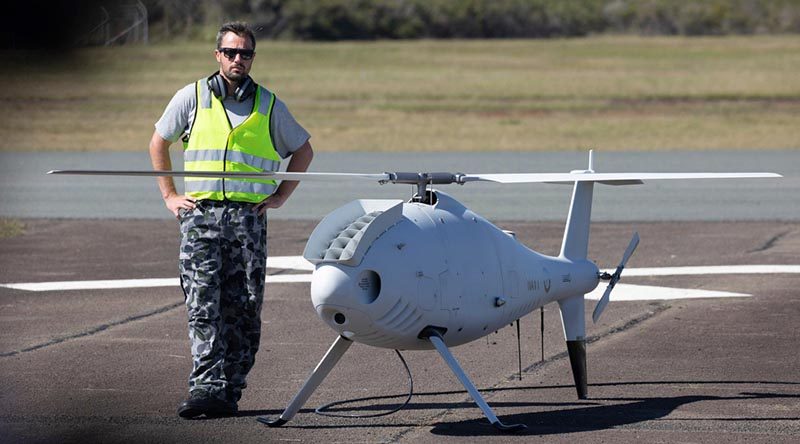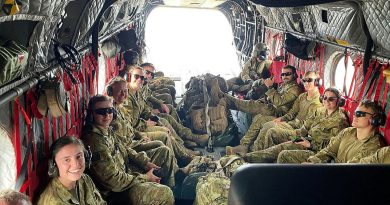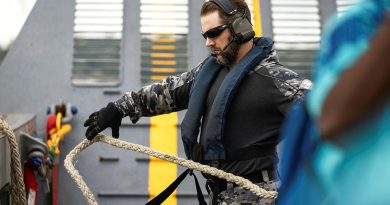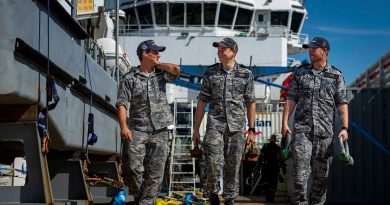822X Squadron flies two different UAVs at the same time
Share the post "822X Squadron flies two different UAVs at the same time"

822X Squadron reached a milestone in its development on 25 February 2020 when it flew simultaneous missions of both of its aircraft types – the Insitu ScanEagle unmanned aircraft system and the Schiebel S-100 Camcopter unmanned aircraft system.
CAPTION: Petty Officer Aviation Technician Avionics Rodney Ferreira, stands by the Schiebel S-100 Camcopter prior to its flight at Jervis Bay airfield. Photo by Chief Petty Officer Cameron Martin.
The sorties were conducted from 822X Squadron’s operating facility at Jervis Bay airfield.
This occasion also marked the first Navy operated flights of the new S-100 S2 heavy-fuel engine aircraft following recent acceptance of the aircraft into service.
S-100 Camcopter has logged more than 30,000 flight hours around the world from land bases and many different ship classes.
S-100 unmanned aerial system consists of one or more remotely piloted aircraft and a ground-control station with associated antennae and interconnections necessary for aircraft command and control.
S-100 Camcopter is a small-to-medium-sized vertical take off and landing aircraft made of titanium and carbon fibre materials, designed to carry multiple payloads simultaneously for up to six hours at a time.
ScanEagle is one of the most widely used tactical unmanned surveillance aircraft in the world, having flown over one million flight hours globally.
The ScanEagle system consists of multiple remotely piloted aircraft, a pneumatic catapult launcher, a Skyhook recovery system, and a ground control system.
ScanEagle RPA is a small carbon fibre, long endurance, fixed-wing aircraft capable of operation from land bases and seagoing vessels without the need for a runway.
Schiebel S-100 Camcopter
| System Type |
Unmanned aerial vehicle (UAV)
|
|---|---|
| Status |
Operational evaluation
|
| Manufacturer |
Schiebel
|
| Launch and recovery… |
Vertical take off and landing
|
| Origin |
Austria
|
| Length |
3.46 metres
|
| Rotorspan |
3.4 metres
|
| Width |
1.24 metres
|
| Weights |
|
| Speed |
|
| Endurance | 5+ hours |
| Altitude | 19,500 feet |
| Engines | 1 x twin rotor HFE 2 stroke engine (JP-5 or JP-8 heavy fuel or AVGAS) |
| Operated by |
822X Squadron
|
Insitu ScanEagle.
| System Type |
Unmanned aerial vehicle (UAV)
|
|---|---|
| Status |
Operational evaluation
|
| Manufacturer |
Boeing Insitu
|
| Role |
|
| Launch and recovery |
Pneumatic catapault launcher and Skyhook recovery system
|
| Origin |
USA
|
| Length |
1.6 metres
|
| Wingspan |
3.1 metres
|
| Weights | 22kg max takeoff weight |
| Speed |
|
| Endurance | 12+ hours |
| Altitude | 15,000+ feet |
| Crew |
Up to 5 (mission commander and up to four cross-trained remote pilot/maintenance crew members)
|
| Engines | 1 x 28cc two-stroke engine (JP-5 or JP-8 heavy fuel or C-10 petrol) |
| Sensors |
|
| Operated by |
822X Squadron
|
.
.
.
.
.
.

.
.
Share the post "822X Squadron flies two different UAVs at the same time"





